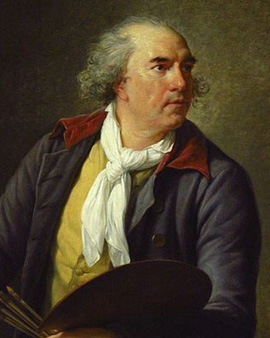The Frenchman Hubert Robert was a painter who was born in May 1733 in Paris. Unfortunately little is known about his childhood. His father is said to have been a high official in Paris. At the age of 12 he began his school education at the university, the Jesuit Collège de Navarre, which was founded in 1304 by Joan of Navarre, wife of the French king. Here the young Hubert was not only taught painting, but also logic, grammar and theology. The French sculptor René-Michel Slodtz became Hubert's favourite lecturer. He followed with great interest his explanations about the different perspectives and constantly improved his drawings a little bit further. It is said that it was only thanks to Slodtz' instructive teaching that Hubert Robert made the decision to pursue a career as a painter.
After six years at the University of Paris he went to Rome. Here he lived for eleven years and built up a large circle of friends and acquaintances. This included some of the most important artists, painters and writers of the time. Giovanni Battista Piranesi and Giovanni Paolo Pannini, who also lived in Rome, probably had a special influence on his further development. Piranesi began his career as an engraver before working as an archaeologist and architect. Pannini, on the other hand, was a well-known Roman veduta painter.
After his stay in Rome, Hubert Robert returned to his home town Paris. It was the year 1793 and Hubert celebrated his 60th birthday in troubled times. The great terror of the French Revolution was approaching. At the beginning of the year, members of the Party of the Jacobins beheaded the French King Louis XVI with the guillotine in front of the public. Throughout the country, people who the Jacobins believed to be opponents of the revolution fell victim to the bloody terror. Also Robert was imprisoned in the same year. He was held in the Paris prisons Saint-Pélagie and Saint-Lazare. Only after the overthrow of Robespierre was he freed, that was in the summer of 1794, but the French Revolution was to last another five years. Robert joined the Jacobins and became a member of the National Convention. The "Convention nationale" was the revolutionary representation of the people. The Convention was replaced by the National Assembly, which was the first national parliament in Europe. The French Revolution ended with the adoption of the Declaration of Human and Civil Rights in 1799. From then on, the monarchy was history and the citizens could in future have a say in the development of their country in free elections. The French Revolution was one of the most momentous events in the long history of Europe. Hubert Robert still experiences the first, peaceful years after the revolution and the beginning of the 19th century. He died in 1808, at the age of 75 in his native Paris.
×





.jpg)
.jpg)
_-_(MeisterDrucke-903803).jpg)
_-_(MeisterDrucke-903803).jpg)
.jpg)
.jpg)
.jpg)
.jpg)
.jpg)
.jpg)
.jpg)
.jpg)
.jpg)
.jpg)
.jpg)
.jpg)
.jpg)
.jpg)
.jpg)
.jpg)
.jpg)
.jpg)
.jpg)
.jpg)
.jpg)
.jpg)
.jpg)
.jpg)
.jpg)
.jpg)
.jpg)
.jpg)
.jpg)
.jpg)
.jpg)
.jpg)
.jpg)
.jpg)
.jpg)
.jpg)
.jpg)
.jpg)
.jpg)
.jpg)
.jpg)
.jpg)
.jpg)
.jpg)
.jpg)
.jpg)
.jpg)
.jpg)
.jpg)
.jpg)
.jpg)
.jpg)
.jpg)
.jpg)
_-_(MeisterDrucke-1519885).jpg)
_-_(MeisterDrucke-1519885).jpg)
.jpg)
.jpg)
.jpg)
.jpg)
_-_(MeisterDrucke-1658175).jpg)
_-_(MeisterDrucke-1658175).jpg)
 - (MeisterDrucke-67618).jpg)
 - (MeisterDrucke-67618).jpg)
_18th_century_Musee_du_c_-_(MeisterDrucke-1021908).jpg)
_18th_century_Musee_du_c_-_(MeisterDrucke-1021908).jpg)
.jpg)
.jpg)
.jpg)
.jpg)
_-_(MeisterDrucke-1658296).jpg)
_-_(MeisterDrucke-1658296).jpg)
.jpg)
.jpg)
.jpg)
.jpg)
.jpg)
.jpg)
.jpg)
.jpg)
.jpg)
.jpg)
.jpg)
.jpg)
_-_(MeisterDrucke-1657255).jpg)
_-_(MeisterDrucke-1657255).jpg)
.jpg)
.jpg)
Romeinse_gezichten_(_-_(MeisterDrucke-1367701).jpg)
Romeinse_gezichten_(_-_(MeisterDrucke-1367701).jpg)
.jpg)
.jpg)
_179_-_(MeisterDrucke-1002789).jpg)
_179_-_(MeisterDrucke-1002789).jpg)
.jpg)
.jpg)
.jpg)
.jpg)
_-_(MeisterDrucke-1658310).jpg)
_-_(MeisterDrucke-1658310).jpg)
.jpg)
.jpg)
.jpg)
.jpg)
.jpg)
.jpg)
.jpg)
.jpg)
 in the Grande Galerie of the Louvre 20th December 1797 - (MeisterDrucke-84647).jpg)
 in the Grande Galerie of the Louvre 20th December 1797 - (MeisterDrucke-84647).jpg)
.jpg)
.jpg)
.jpg)
.jpg)
.jpg)
.jpg)
.jpg)
.jpg)
.jpg)
.jpg)
.jpg)
.jpg)
.jpg)
.jpg)
.jpg)
.jpg)
.jpg)
.jpg)
 in the Tuileries Paris 1794 - (MeisterDrucke-97011).jpg)
 in the Tuileries Paris 1794 - (MeisterDrucke-97011).jpg)
.jpg)
.jpg)
.jpg)
.jpg)
.jpg)
.jpg)
.jpg)
.jpg)
_in_Paris_in_1_-_(MeisterDrucke-983779).jpg)
_in_Paris_in_1_-_(MeisterDrucke-983779).jpg)
.jpg)
.jpg)
.jpg)
.jpg)
.jpg)
.jpg)
.jpg)
.jpg)
.jpg)
.jpg)
.jpg)
.jpg)
_-_(MeisterDrucke-1657962).jpg)
_-_(MeisterDrucke-1657962).jpg)
.jpg)
.jpg)
_-_(MeisterDrucke-587821).jpg)
_-_(MeisterDrucke-587821).jpg)
 and Marie-Antoinette (1755-1793) at the entry of the Tapis Vert in the Gardens of Versailles 1775 (colour engraving) (detail) - (MeisterDrucke-146781).jpg)
 and Marie-Antoinette (1755-1793) at the entry of the Tapis Vert in the Gardens of Versailles 1775 (colour engraving) (detail) - (MeisterDrucke-146781).jpg)
.jpg)
.jpg)
.jpg)
.jpg)
.jpg)
.jpg)
_-_(MeisterDrucke-903986).jpg)
_-_(MeisterDrucke-903986).jpg)
.jpg)
.jpg)
.jpg)
.jpg)
.jpg)
.jpg)
.jpg)
.jpg)
_-_(MeisterDrucke-1657665).jpg)
_-_(MeisterDrucke-1657665).jpg)
.jpg)
.jpg)
.jpg)
.jpg)
.jpg)
.jpg)
.jpg)
.jpg)
.jpg)
.jpg)
.jpg)
.jpg)
.jpg)
.jpg)
_huile_sur_t_-_(MeisterDrucke-1325974).jpg)
_huile_sur_t_-_(MeisterDrucke-1325974).jpg)
.jpg)
.jpg)






